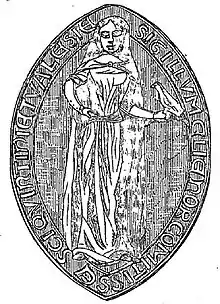Eleanor, Countess of Vermandois
Eleanor of Vermandois also known as Eléonore de Vermandois (1148 or 1149 – 19 or 21 June 1213) was ruling countess of Vermandois in 1182-1213 and by marriage countess of Ostervant, Nevers, Auxerre, Boulogne and Beaumont. She was a daughter of Ralph I, Count of Vermandois, and his second spouse, Petronilla of Aquitaine.
Eleanor | |
|---|---|
 | |
| Countess of Vermandois | |
| Born | 1148/1149 |
| Died | 19 June or 21 June 1213 |
| Buried | Aisne, France |
| Noble family | Capetian House of Vermandois |
| Spouse(s) | Godfrey of Hainaut William IV, Count of Nevers Matthew, Count of Boulogne Matthew III, Count of Beaumont |
| Father | Ralph I, Count of Vermandois |
| Mother | Petronilla of Aquitaine |
Early life
Eleanor was the youngest of three children born to her father by his second marriage. Eleanor's two older siblings were Ralph II, Count of Vermandois and Elisabeth, Countess of Vermandois. She had an older half-brother from her father's first marriage: Hugh II, Count of Vermandois. A couple of years after the birth of Eleanor, her parents divorced; her father remarried to Laurette of Flanders in 1152 but died later that same year.
At the time of her birth, Eleanor was fourth in line to inherit the Vermandois title so therefore was not expected to inherit with two older brothers and a sister ahead of her in the line of succession.
Marriages
Eleanor was married firstly in her mid-teens to Godfrey of Hainaut, Count of Ostervant, heir to his father Baldwin IV, Count of Hainaut. The couple married in 1162, however, Godfrey died the following year, whilst preparing for a journey to the territory of Palestine.
Her second marriage in 1164 was to William IV, Count of Nevers; this marriage was also brief lasting only four years when William died at Acre in 1168 on crusade.
A third marriage occurred in 1171 between Eleanor and Matthew, Count of Boulogne,[1] who had divorced his first wife Marie, Countess of Boulogne the previous year. This marriage produced Eleanor's only child, a short lived daughter. No further children could be born as Matthew died in 1173 whilst fighting at the siege of Trenton (now Neufchatel-en-Bray); he was shot by an archer wielding a crossbow.
A fourth marriage took place in 1175 to Matthew III, Count of Beaumont. They were married for seventeen years - Eleanor's longest marriage - but they had no children and in 1192, Matthew and Eleanor divorced. Eleanor had no surviving children from any of her four marriages.
Countess

Eleanor was originally fourth in line to the inheritance of the county, being her father's youngest child. However, her oldest brother Hugh II abdicated to become a monk in 1160, her second brother Ralph II died of leprosy in 1176, leaving no children and Eleanor's sister Elisabeth died in 1183. Her marriage to Philip I, Count of Flanders, had produced no children; therefore, Eleanor could then rightfully inherit the County of Vermandois.[2]
Upon the death of Elisabeth, her widower Count Philip refused to pass over control of Vermandois to Eleanor; she then appealed to Philip II of France for support. Under the Treaty of Amiens on 20 March 1186, Eleanor retained Valois and part of Vermandois, calling herself at that point Countess of Valois, then upon the death of Philip in 1192, she inherited the rest of Vermandois on the condition that King Philip was able to annex Vermandois into the royal domain if Eleanor died without children.[3]
From that point onward, Eleanor reigned solely over Vermandois.[4] Eleanor was remembered as a witty yet pious woman.[5] She founded the Abbey of Parc-aux-Dames in Auger-Saint-Vincent, she loved poetry and gave the minister Renaud impetus to the Constitution of the Roman de Sainte-Geneviève.[6] She also donated property to Notre-Dame by charter dated 1189.[7]
Eleanor died childless in 1213 at the age of sixty after a 21-year rule over Vermandois, and she was buried in the Abbey of Longpont (today she is buried in Aisne). Upon Eleanor's death, King Philip took over control of all of Eleanor's property.
References
- Robert de Torigny, Vol. II, p. 20.
- NORTHERN FRANCE NOBILITY, Medieval Lands
- Medieval Lands
- Kerrebrouck (2000), p. 540.
- Translation from German equivalent
- Translation from German equivalent
- Ourscamp Notre-Dame CCXLVII, p. 149
| Preceded by Elisabeth |
Countess of Vermandois 1182–1192 (disputed with Philip) 1192–1213 (independent rule) |
Succeeded by French crown |